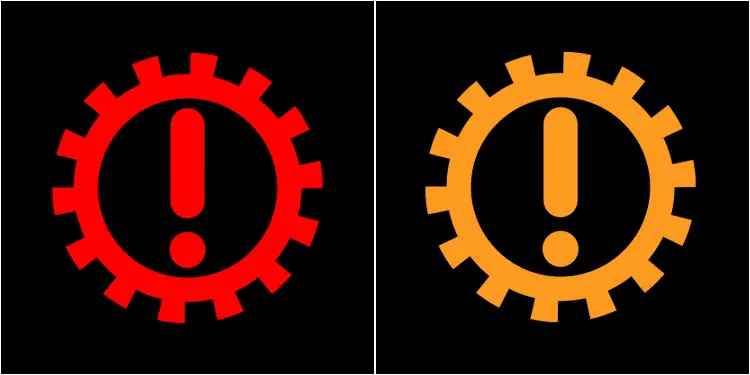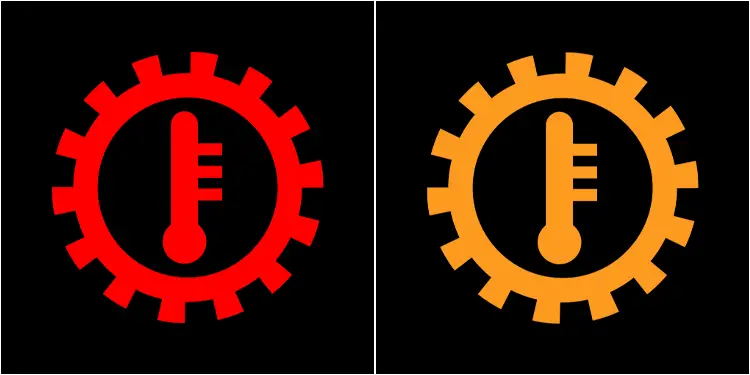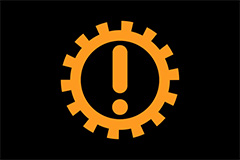What Does the Transmission Warning Light Mean?
Generally, the transmission light indicates a problem with your car’s automatic transmission or associated components.
This light is not present in all automobiles. Instead, the check engine light will alert you of transmission problems.
Also, the appearance and meaning of the light vary depending on your vehicle’s brand, model, and year. You can refer to the user’s manual or our Dash Lights Lookup to better understand this.
Let’s look at some specific transmission warning lights and what each means.

The gearbox symbol with an exclamation mark indicates a problem with the transmission system, including low transmission fluid, transmission overheating, or a problem with the transmission control module.
In most cases, the symbol color shows you the level of seriousness.
- The red transmission light is more serious. You need to pull over and have the system checked immediately.
- For the yellow one, you can continue driving at a moderate speed but try to inspect the cause as soon as possible to avoid further damage.

The gearbox symbol with a thermometer means the transmission is overheating. This can be caused by a lack of transmission fluid, heavy load or towing, or a malfunctioning cooling system. When this warning light comes on, pull over and let the transmission cool down.
The level of seriousness is based on the symbol color (as mentioned above).

Some car brands like Nissan, Infiniti, or Mazda use the AT light or AT Check light instead. It comes on when your vehicle’s computer detects a problem with the transmission system. You should have it checked as soon as possible.
Is It Safe to Drive With the Transmission Light On?
No. I don’t recommend doing so. The more you drive with this light, the worse the situation. It can even damage the permanent transmission, putting you and your vehicle at risk. And you certainly don’t want that to happen.
It’s best to pull over and follow my guide below.
Why Is The Transmission Light On?
There’s no one-liner answer for this. This is because an illuminating transmission light can occur for many reasons. The most common ones are as follows.
In general, most transmissions operate at a temperature range between 175-200°F. However, you should note some driving conditions can lead to transmission overheating, including:
- Driving in hot weather for a long period
- Towing a trailer
In these situations, stop your car to allow the transmission cool down.
If the system detects the fluid drops below the threshold, it will trigger the light to come on.
Thus, refilling the transmission fluid is the only solution in this case.
Unlike motor oil, transmission fluid does not burn with time, and the low fluid level might be a sign of leakage somewhere. You should get your vehicle checked for fluid leaks by a professional.
In fact, a car maintenance service helps you detect the problem at its early stages and prevent serious (and costly!) transmission damage.
Therefore, ask a mechanic to inspect and repair these damaged parts or even replace the whole component if needed.
Issues with the valve body can adversely affect the transmission system, such as slipping, rough shifting, or failure to engage gears – ultimately turning the transmission warning light on.
The shift interlock function ensures that your vehicle is safe and stationary before you can shift into gear. If this system malfunctions, the check transmission light may appear.
What to Do When the Transmission Light Comes On?

Step 1: Stop driving and let your transmission cool down
This will help prevent further damage to the transmission or other components. At the same time, the transmission temperature lowers by passing the coolant and letting the heat flow in the air outside your vehicle.
Step 2: Check the transmission fluid condition and level
In case the light doesn’t go off, check the transmission fluid level with a dipstick.
- Locate the dipstick, clean and reinsert it.
- Remove the dipstick.
- Check the transmission fluid condition by its color:
- Reddish-pink color: Your fluid is healthy.
- Brownish-red color: Your fluid is getting to the point of needing a replacement.
- Dark color: Your fluid needs replacing immediately.
- Check the transmission fluid level by the dipstick:
- If it drops below the “Min” level, it’s time to refill the fluid.
- If it goes above the “Max” level, you’ll need to drain some fluid from your car.
- The fluid level should be between the “Min” and “Max” lines.
Note: Change the transmission fluid every 60,000 miles to 100,000 miles.
Step 3: Use a transmission code reader to find out the cause
You follow the two steps above, but the light remains lit. It’s time to use a transmission code reader. This tool will help you read the transmission codes stored on your vehicle’s computer.
After that, figure out what the codes mean by using the DTC Lookup Library on the tool or going to the OBD2 Codes Lookup to find meaning, causes, symptoms, and fixes.
Step 4: Repair the malfunctioning or broken parts
Get your vehicle to a professional to repair or replace the faulty parts if you’re unsure how to do it.
Step 5: Reset the transmission light
Once done, choose the “Erase” function on the scanner to clear the transmission codes.
Next, restart your engine and go for a test drive. The transmission light will be gone.
What’s Next?
Now, you get the solution for your flashing transmission light. The next step is to prepare a transmission code reader to pinpoint the exact cause behind this flash.
Not sure about which tool to buy? Read my review on the best transmission code readers to get your hands on the best product on the market!
Is my guide easy to follow?
If you have any questions, leave a comment below. I will try to support you.
Learn more: O/D Off Light: What Does It Mean? Is It Safe to Drive With It?









Recommended for you
Troubleshooting BMW Transmission Malfunction: Causes and Fixes
What is ECT Power? When Should You Use It?